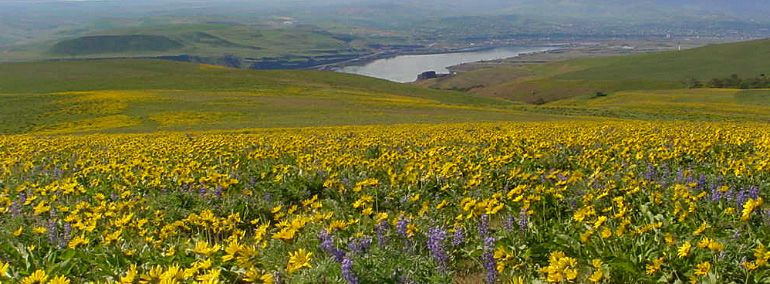Columbia Hills Natural Area Preserve

Columbia Hills Natural Area Preserve (NAP) is located on the crest of the Columbia Hills at the east end of the Columbia River Gorge National Scenic Area, 17 miles southwest of Goldendale, adjacent to Columbia Hills State Park. Columbia Hills NAP, which is currently 3,644 acres, was established in 1993 after being identified by the Washington State Natural Heritage Program as a priority for protecting Washington’s largest populations of three rare plants: obscure buttercup (Ranunculus reconditus) — state endangered, Douglas’ draba (Cusickiella douglasii) and hot-rock penstemon (Penstemon deustus var.variabilis), both state threatened.
The NAP also supports the largest known high-quality examples of two plant communities: Idaho fescue-houndstongue hawkweed grassland (Festuca idahoensis-Hiercacium cynoglossoides), Douglas’ buckwheat / Sandberg’s bluegrass scabland (Eriogonum douglasii / Poa secunda), and thyme buckwheat / Sandberg’s bluegrass scabland (Eriogonum thymoides / Poa secunda). Oak-pine woodlands, basalt cliffs, and a number of natural springs add to the diversity of habitats found on this large site.
Columbia Hills NAP is home to a variety of wildlife species including mountain lion, black bear, mule deer, porcupines, Douglas tree squirrels, coyotes, and several snake and lizard species. Large numbers of birds, including neotropical migrants and raptors, nest and feed in the various habitats within the NAP. A rich and well-documented cultural history and exquisite panoramic views contribute to this site's significance.
Features protected: Three rare plant species (obscure buttercup, Douglas’ draba, hot-rock penstemon), Idaho fescue – houndstongue hawkweed grassland, Douglas’ buckwheat / Sandberg’s bluegrass scabland, thyme buckwheat / Sandberg’s bluegrass scabland.
Ecoregion: Columbia Plateau (Klickitat County)
Ecoregion: Columbia Plateau (Klickitat County)
Science, Research and Monitoring
Public and private universities, other research institutions and individual researchers may contact DNR to propose a research project at the site. If you are interested in pursuing research at Columbia Hills NAP, please contact David Wilderman, Natural Areas Ecologist, at david.wilderman@dnr.wa.gov
Examples of research and monitoring projects
- Rare plant population monitoring, including an annual volunteer effort tracking the obscure buttercup.
- Comparison of genetic diversity of the rare obscure buttercup and the common sagebrush buttercup.
- Wilderman, D.L. 2001. Population characteristics and demographics of obscure buttercup (Ranunculus reconditus Nels. & Macbr.). Pp. 84-91 In: Reichard, S.H., P.W. Dunwiddie, J.G. Gamon, A.R. Kruckeberg, and D.L. Salstrom (editors), Conservation of Washington’s native plants and ecosystems. Washington Native Plant Society, Seattle. 223 pp.
- Zakharov, E. V. and Hellmann, J. J. 2008. Genetic differentiation across a latitudinal gradient in two co-occurring butterfly species: revealing population differences in a context of climate change. Molecular Ecology, 17: 189–208.
Environmental Education and Public Access
To help conserve the ecology of this preserve, dogs and bicycles are not allowed.
A primitive road that climbs 2 1/2 miles through the NAP to the ridge-crest is open for pedestrian access, with a small parking area and information kiosk located at the entrance. Walking this road provides visitors with close-up views of many of the wildflowers that grow along the 1,200-foot elevation gradient that the road traverses, as well as stunning views from the ridge-crest.
The site is frequently used for organized field trips by native plant groups, geologists, archaeologists, and birding groups. The adjacent Columbia Hills State Park offers additional opportunities including hiking, camping, and interpretive tours.
For information on educational opportunities, please contact the DNR Southeast Region Natural Areas Manager.
Volunteer and Stewardship Opportunities
Volunteers help with a variety of activities on Natural Areas, including invasive species control, restoration, and monitoring. If you are interested in volunteer and stewardship opportunities at Columbia Hills NAP, please contact the Southeast Region Natural Areas Manager.
Directions to the site
From State Route 14 on the Columbia River, turn onto Dalles Mountain Road, between milepost 84 and milepost 85. Follow Dalles Mountain Road for 3 miles until you reach the Dalles Mountain Ranch (historical house and barns). A road to your left will lead another 1.5 miles up the hill to the NAP entrance.
A Washington State Discover Pass is required for parking at this site. This funding helps DNR manage these important natural areas across the state.

